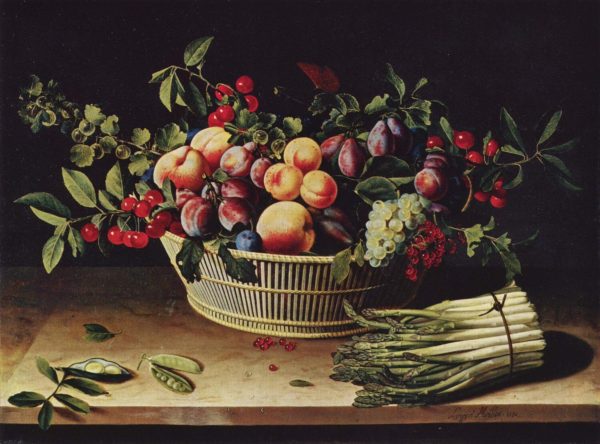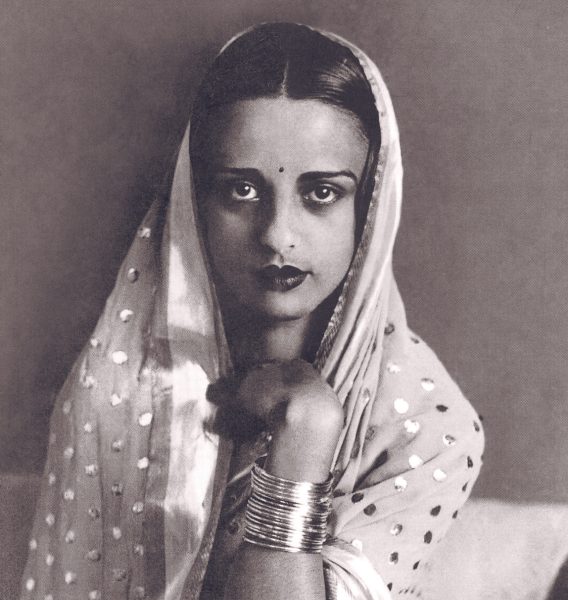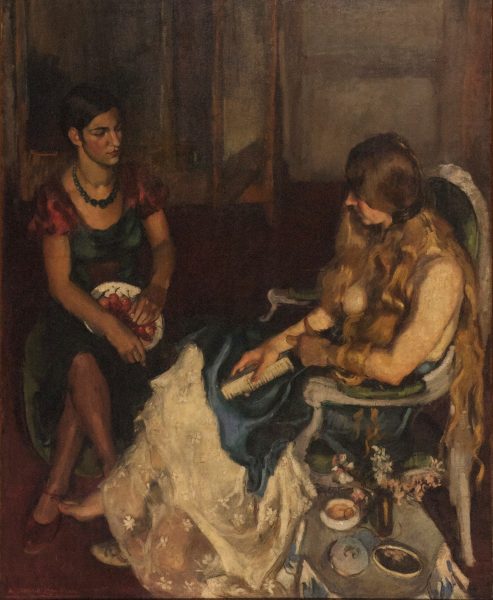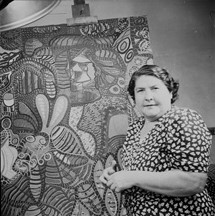The self-expression of painting is meticulous, being able to express different emotions through each piece. Artist’s lives are filled with vibrant hues or monochromatic tones, each stroke of the paintbrush telling a different story.
Art is indispensable to human life, its essence captivating society. And female artists throughout history have painted their own stories straight from their canvases, their artworks depictions of how they view the world around them.
Beatriz Reyes, a freshman, artist and former fine arts student, mainly specializes in painting portraits and still life. Reyes shared her opinion on how she views art personally.
“Art is able to express feelings that words can’t say. Sometimes words aren’t enough, so art shows how I view the world,” Reyes said. “I really hope I can keep doing art somewhere in the future, and that my [art] skills will continue on.”
Women’s History Month from March 1 to March 31, recognizes women all around the world from all walks of life, celebrating their impact on the world throughout time. Here are three female painters throughout history who have illustrated their greatness in the world through their painting.
#1 Louise Moillon
Background
Louise Moilion, a French artist, was born around 1609-1610 in the Baroque period in an era that focused on still-life paintings–(natural inanimate objects). She was born into an artistic family of seven, in a Calvinist-protestant majority neighborhood in Paris, France.
According to the National Museum of Women in the Arts her father Nicolas Moillon was a recognized painter and distinguished art gallery owner. Moillon, influenced by her family and own ideas, fancied painting in her childhood, painting as early as the age of nine. In addition, ArtHerStory mentioned that Moillon went to an art institution which helped her to sharpen more of her skills, one of them being art.
It was at this moment when her passion for painting skyrocketed. After her father passed away in 1619, her mother remarried François Garnier, a still-life painter who became Moillon’s stepfather. It was said that Garnier was a mentor and trainer to Moillon who also influenced Moillon to pursue art, specifically still-life paintings.

Artworks and Distinctions
Louise Moillon’s paintings were oil-based, mostly consisting of vibrant, ripe fruits displayed in either baskets or china bowls. However other times, she would incorporate people into her works. These paintings reflected parts of her daily life in France.
According to the National Museum of Women in the Arts, Louise Moillon’s art became known to the public when Moillon pleaded for her stepfather to have her art displayed next to his in an exhibit. When she displayed her artwork, it sold out instantly, and this single moment was the start-up to her success.
From then on, she distinguished herself as one of the best still-life painters in her lifetime, even having paintings bought from high nobility–one of them being King Charles l.
Louise Moillon died in 1696, at 86 years old. Musée Protestant stated she produced around forty works in her lifetime between 1630-1640.
#2 Amrita Sher-Gil
Amrita Dalma Sher-Gil, an Indian-Hungarian artist, was a pioneer who focused on modern avant-garde fusions. Through her art, she shined light on civil issues and went against the standards placed upon her, paving the way for future artists to follow.
Background

Sher-Gil was born in Budapest, Hungary on January 30 1913 to a family abundant in the lifestyle of arts. Her father Umrao Singh Sher-Gil was an aristocrat and Sikh scholar, but he also engaged in photography. Furthermore, Sher-Gil’s mother Marie Antoinette Gottesman was an opera singer.
Sher-Gil, like many other artists, shared an interest in art from a young age. Art History School mentions Sher-Gil’s family noticed her talent for the arts and tried to place her with multiple teachers as well as in art institutions in different countries.
Despite the family’s efforts, Sher-Gil disliked the majority of the teachers and academies because of their formality. However, in 1929, Sher-Gil’s mother and sister relocated back to Europe–more specifically in Paris, France– after living in India where she enrolled in the Ecole des Beaux Arts academy. Sher-Gil enjoyed this school and was influenced by many European works that expanded her views in art.
After her training at the Ecole des Beaux Arts, Her stated that Sher-Gil’s interest in India’s cultural heritage grew. So in 1934, Sher-Gil returned to India to gain inspiration from her culture. There she documented many of the village people’s lives through her artwork.
Artworks and Distinctions
Sher-Gil’s art can be seen as authentic and alluring, using a blend of traditional methods that she acquired from both India and Europe. She had a wide array of subjects including herself, friends, and family, as well as scenes from her life in both Europe and India.
Sher-Gil’s art stood out from other pieces in the male-dominated field of her time. Her paintings also reflected the natural state of women, embracing their raw appearances and expressions in common settings.
Sher-Gil led a short life, dying on December 5, 1941, at only 28 years old. Yet her art prevailed far past her, setting

precedents in the Indian art world.
Daily Art Magazine reports that her works like “Young Girls” led to Sher-Gil’s election as an Associate of the Grand Salon in Paris in 1933, making her the youngest ever and the only Asian artist to have received the recognition. Other of her works like “Storyteller,” mentioned by Art Fervou, has been one of the most expensive pieces of art ever sold by an Indian artist.
#3 Amelia Peláez
Amelia Peláez del Casal was a Cuban artist who focused on painting and ceramics. Her works helped to establish her title as one of Cuba’s most remarkable artists of the 20th century.
Background
Peláez was born in Yaguajay, Cuba on January 5, 1896. She was born into a large family, being the fifth born out of 11 siblings. Her father was a doctor, and her mother stayed home with Peláez and her siblings.
Peláez attended multiple academies throughout her life. The first academy she attended was the San Alejandro Academy after her family moved to Havana. There she studied under Leopoldo Romañach and thus graduated in 1924 where she also exhibited some of her early landscape and portrait works.
ArtNet stated that after Peláez’s time at the San Alejandro Academy, the government granted her money to study

abroad. As a result, Peláez went on to places like New York’s Arts Students’ League–for a summer course–, the Nationale Supérieure des Beaux-Arts and the Académie des Beaux-Arts of the Musée du Louvre.
In Peláez’s time abroad, she met people such as a Russian painter named Alexander Exter who helped to shape and influence her art style. The International Center for the Arts of the Americas said that Exter specifically introduced Peláez to cubism and abstract style art.
Peláez then returned back to Havana in 1934 where she would reside for the rest of her life to focus on her art career. International Center for the Arts of the Americas also reports that when Peláez was back in Cuba, she joined a body of artists titled as the ‘Cuban avant-garde movement.’
Artworks and Distinctions
In Cuba, Peláez’s paintings focused on the surroundings of her motherland. The majority of Pelaez’s works reflected Cuba’s women like in her piece “Las Dos Hermanas” or botany like in the piece “Bucaro of Flowers.” These were illustrated through abstract shapes and vibrant colors that helped to give a sense of ‘life’ to her works.
According to Arbol Rojo, Peláez’s works gained many awards throughout her time including the National Exhibition of Painting and Sculpture Award.
Despite Peláez’s passing on April 8, 1968, her work is now housed globally in places such as Europe, Latin America, and the United States. Peláez helped to share Cuba’s culture through her art, establishing her as one of Cuba’s most renowned female artists.
Celebrating Women and Women in the Arts
As the world celebrates women’s accomplishments during Women’s History Month, these three female artists left a lasting legacy in the arts.
Diana Choung, a graphic designer who also participates in art as a side hobby, gave her personal insights on female artists.
“I like seeing women who have paved their own way through art or just women on the margins,” Choung said. “I think they’ve made a way to create a name for themselves or be influential to people who don’t have a voice, or that isn’t as commonly seen in public media.”








